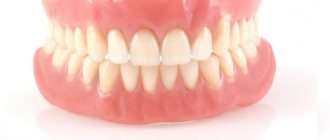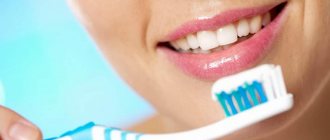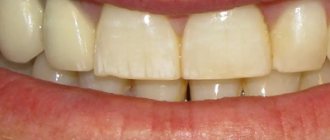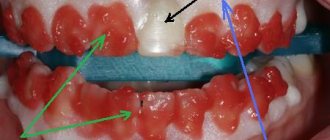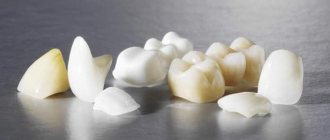Stages of bite deformation in children and adults
Doctors distinguish several stages of bite deformation.
The first is considered the easiest. It is diagnosed when the patient has a curvature of one or more teeth - they may have an irregular shape or length, an abnormal inclination and location, or may be rotated around their own axis.
The second or middle stage involves malocclusion throughout the entire row on one jaw or both.
To the third, most severe stage, experts include pathologies associated with the abnormal structure and size of the maxillofacial apparatus relative to the skull, violation of the position of the upper and lower jaws relative to each other, and the degree of closure of the teeth.
Important! Any, even the most minor, deformation of the bite, at a minimum, leads to a violation of the aesthetics of the smile and facial proportions, and at a maximum – to serious health problems. For example, to dental diseases and gastrointestinal pathologies, to respiratory failure, hypertonicity of the masticatory muscles and overload of the maxillofacial joint, to headaches, to early loss of teeth.
HOW TO CARE FOR A TEMPORARY CROWN
There are several rules for caring for temporary crowns so that they serve you until you are replaced with permanent ones: • Temporary cement is not very strong, so do not eat sticky and viscous foods - they can peel off the crown; • Try to chew less where the crown is installed; • Brush your teeth gently, especially around the temporary crown.
If the temporary crown falls out, you should contact your dentist as soon as possible to have it re-fixed. It is not recommended to sleep with a loose temporary crown in your mouth - you may accidentally swallow it.
Indications for installing crowns for crooked teeth
If a patient is diagnosed with the first stage of bite deformation, when the defect involves 1-2 elements, then it is quite possible to solve the problem with the help of crowns. Their installation is indicated when the following anomalies are present:
- the tooth is rotated around its axis, tilted, has an irregular shape or a shortened/elongated crown part: you can align, or, more precisely, correct such teeth with crowns and make sure that they do not stand out from the rest,
- trema and diastema: designs will help fill excess space, reduce unaesthetic gaps,
- hard tissues are severely damaged as a result of caries, injury, or there is a chip: in this case, the product will help strengthen hard tissues, protect them from the effects of negative factors, from premature destruction or removal,
- slight crowding: for example, when the two front teeth overlap each other slightly.
The doctor may also recommend the installation of dentures before orthodontic treatment or at the final stage of bite correction using braces, aligners or trainers.
Which crowns are best for back teeth?
The lateral teeth bear the basic load, so for their reconstruction it is worth using the strongest prosthetic products. Aesthetics in this case are less important. However, not any unaesthetic material (metal) will be compatible with soft tissues - this is also worth taking into account when choosing crowns for molars.
Metal prostheses are reliable and inexpensive, they very rarely break. The disadvantages of prosthetics with metal crowns are a low level of aesthetics and a high risk of developing allergies.
You can solve the problem of material incompatibility with fabrics by choosing products made of precious metals (gold-platinum alloy) for installation. They are safe and non-toxic. However, the price of a crown will be comparable to the cost of a ceramic product.
The most preferred option for prosthetics of lateral teeth remains metal-ceramics. This choice of most patients can be called justified, because a metal-ceramic crown is an excellent ratio of price and quality. Compared to a metal structure, such a prosthesis is inferior only in strength (there is a risk of chipping the ceramic coating). Blueness of the gums, which is formed as a result of contact between metal and soft tissues, is not embarrassing, since we are talking about prosthetics in the area of chewing teeth.
It is not recommended to place all-ceramic structures on teeth, since they are not very durable - there is a high risk of chipping and breaking. An alternative to classic ceramics can only be E-max glass ceramics - a durable analogue at a higher price.
Products made from zirconium dioxide are the strongest and most durable, which is why they are often recommended for use in dental restoration. However, in this case, it is preferable to use exclusively monolithic zirconium crowns (the veneer may break off).
What are the contraindications
Correcting crooked teeth with crowns will not work if you have serious malocclusions that affect the entire jaw and affect its functionality. In this case, you cannot do without orthodontic appliances or even their combination with surgery.
Important! Why can’t prosthetics be done with crowns if, for example, there are anomalies not in 1-2, but in a whole number of teeth? The restorations will be unstable and short-lived, and their functionality will also be very mediocre. Thus, due to improperly distributed load, structures can chip, break, and even move apart, forming gaps between the teeth.
Installation is contraindicated for patients with inflammation of periodontal tissues, leading to loosening of the row. For example, with periodontitis and periodontal disease. Also, prosthetics should not be performed on people with bruxism or neuropsychiatric disorders.
Reviews from doctors and patients
Dentists consider dentures with crowns to be an excellent way to restore significantly damaged elements. Doctors note a significant advantage of this solution - it is an opportunity to prevent the destruction of a “dead” tooth or even preserve a “living” unit (if it is partially destroyed). This method cannot be called universal only because it has a number of contraindications, one of which is root damage.
Patients, for the most part, speak positively about prostheses of this type. They note the rapid restoration of functionality and aesthetics of the series, ease of use and durability of the prostheses.
Materials for the manufacture of structures
Materials can be very different:
- alloys of noble and base metals in pure form,
- metal ceramics,
- solid ceramics,
- zirconium dioxide,
- metal-plastic,
- plastic.
The desire of patients to install crowns in order to correct curvature, shape and position most often arises if the defect is present on the front teeth, which are noticeable to others. If you want to achieve maximum aesthetics specifically in the smile area, and for the result to please you for a long time, then it is better to choose designs made of ceramics and zirconium dioxide, because these materials most accurately imitate the structure, color and shine of enamel. Plus, their appearance does not change throughout their entire service life; they are not stained by food.
“My four front teeth on the upper jaw are healthy, without fillings or holes, but they were crooked. I really wanted a Hollywood smile without flaws and, naturally, as quickly as possible. I asked the doctor if it was possible to straighten them and give them aesthetics with crowns. I was ready to install the best and most expensive ones! But the dentist directly said that she would not take such a sin on her soul, and she would not deprive or file away living, albeit crooked, teeth. Why, he says, do you need this, so that they rot inside and slowly fall apart. Then you’ll take them off in 10 years, you’ll still be young, but you’ll need to remove them. Better, he says, go to the orthodontist. I then thought about it and followed her advice. I wore braces for a year and a half, then retainers for the same amount of time. And, in principle, I was satisfied with the result. The only thing I don’t like now is the color of the enamel, white spots have appeared, I want to bleach it.”
Flo, fragment of a review from the dental portal gidpozubam.ru
Comparative characteristics of different types of dental crowns
The table below shows the characteristics of popular types of dental crowns. This information should be taken into account when choosing crowns for the front or chewing teeth.
| Comparison parameter | Metal ceramics + gold, silver, palladium | Metal ceramics + nickel, chrome | Pressed ceramics | Zirconium | Aluminium oxide | Metal-plastic |
| Possibilities of prosthetics | ||||||
| Single restoration | + | + | + | + | + | + |
| As part of a dental bridge | + | + | + | + | + | + |
| For metal intolerance | + | — | + | + | + | — |
| For sore gums | + | — | + | + | + | — |
| For sensitive enamel layer | — | — | + | + | + | + |
| Qualitative characteristics | ||||||
| Possibility of fixing without turning | — | — | + | — | — | — |
| Probability of chipping (scale - 5 points) | 2 | 3 | 3 | 1 | 1 | 5 |
| Maintaining aesthetics in % | 80 | 70 | 100 | 100 | 100 | 20 |
| Production | ||||||
| Manual technique | + | + | — | — | — | + |
| Computer modelling | — | — | + | + | + | — |
Obvious advantages of crowns
The advantage is that you can straighten crooked teeth with crowns without long-term orthodontic treatment. At the same time, prosthetic structures promise an instant comprehensive effect: correction of shape, selection of a suitable color, strengthening of hard tissues and preventing their destruction, return of full chewing function.
Given their versatility, crowns seem more preferable to patients than braces. After all, after braces, for example, it is often necessary to carry out fluoridation and remineralization of the enamel, and to fight the stains that appear on it using bleaching. And here, immediately after installation, the smile aesthetics are excellent, and no additional measures to correct it are required.
Can the patient himself understand that it is time to replace the crown?
Certainly! There are a number of signs, the presence of which should give cause for concern.
- The most common is crown edge exposure , when the gingival margin rises and the tooth root becomes visible (“gingival recession”). In this case, root caries may develop, that is, the tooth may be destroyed.
Photo 2.2. The initial stage of exposure of the roots of the teeth under the crowns.
Photo 2.3. The advanced stage of exposure of the roots of the teeth under the crowns.
- Inflammation of the gums around the crown , which manifests itself in redness of the gums, swelling, and bleeding when brushing.
Photo 2.4. Inflammation of the gingival margin of teeth under crowns, associated with inaccurate marginal fit of the crown to the tooth and with a violation of the biological parameters of tooth restoration.
- The appearance of crown mobility . Patients often say that the crown or bridge is “fixed.” This happens especially often when several crowns are combined (some of the crowns of the bridge have become uncemented, while the rest are still holding together).
- The appearance of an unpleasant odor or taste in the crown area.
- Food getting stuck between crown/crown and tooth.
Important! All of the above signs are a mandatory reason to visit the dentist.
Disadvantages that everyone needs to know about
Is it possible to correct crooked teeth with crowns? Structures cannot be treated. They only mask the defect, make it possible to achieve external attractiveness, but do not correct the cause of the pathology, i.e. broken bite. Therefore, their installation is advisable only if the anomaly is minor and does not threaten the health and functionality of the maxillofacial apparatus.
Another significant drawback: installing a crown is an irreversible process. Underneath it, you need to sharpen and depulp the tooth, and after removing the structure, it may even need to be removed. After all, a depulped unit is destroyed much faster than one in which there is living pulp. And in this regard, braces and any orthodontic devices benefit, because... after a course of treatment they can be removed; they do not require such sacrifices, although, of course, you have to wait a long time to get a positive result.
Important! Crowns do not allow you to change the incorrect location of the roots of the teeth and do not eliminate the cause of the anomaly. Therefore, it would be more correct to say that they do not straighten teeth, but only quickly restore their natural shape and color, and correct only individual defects.
Some patients believe that if they install a crown, they will not be at risk of caries or any other dental disease. However, this is a misconception. An inflammatory process can also develop under the structure if the canals were poorly treated, it was installed incorrectly, or due to insufficient hygienic care for the oral cavity.
What determines the service life of a crown?
- The service life and the need to replace the structure greatly depend on the accuracy of manufacturing at all stages. Precision work means that the crown fits to the tooth without gaps, without steps, without voids, oral fluid and food do not get under it, the gums around it do not become inflamed, it is no different from the “native” tooth. It is the precision of manufacturing that determines the quality of work, and therefore is the key to a long service life of the crown. For example, I had to deal with a situation where the crown was made only a year ago, and upon examination, strict indications for its urgent replacement were revealed (due to poor quality, namely inaccurate manufacturing). And vice versa, when examined, the crown meets all the requirements, all parameters are normal, there is no need to replace it, and it has been standing for 10 years (which means it was manufactured very accurately and in a timely manner).
- We have repeatedly mentioned that accuracy, and therefore quality, is at the forefront. If we take quality as a given, then the material and method of fixation come to the fore. So, the service life also depends on the material from which the crown is made and, accordingly, on the method of fixing it to the tooth . Classic metal-ceramics and zirconium dioxide-based crowns are attached to a special “cement,” that is, an intermediary between the crown and the tooth, and do not enter into a “chemical” bond with either this cement or the ground tooth. Namely, this cement is “destroyed” and “washed out” over time, leading to a violation of the seal of the entire structure. Crowns based on lithium disilicate (also called “E-max”) are fixed without an intermediary: using the adhesive (“glue”) method, that is, they are glued to the tooth tissue, which leads to a very strong connection between the crown and the tooth. Accordingly, the service life of such structures is longer than the 5-7 years described above, which means that a crown change will not be required soon.
- In addition, the service life is greatly influenced by the condition of the tooth for which the crown was made. If a patient hesitates for a long time to adequately restore a damaged tooth, he comes for prosthetics at an untimely rate, in particular when the tooth is destroyed by a carious process to the level or below the level of the gum, becoming “soft” and unreliable. In such conditions, the doctor is no longer able to make an accurate marginal fit; such a structure will never be completely sealed, which means the tooth under such a crown will be destroyed. In such conditions, neither good materials nor the method of fixing the crown will help. And if the doctor nevertheless undertakes the restoration of such a tooth, this will be the last crown on it, since it will be impossible to repeat the restoration.
Important! Dear patients, do not delay the restoration of damaged teeth, do not deprive yourself of the opportunity to save your own tooth faster, more reliably and cheaper!
By clicking on the “Make an appointment” button, I consent to the processing of my personal data.
I have read and agree with the conditions for processing personal data set out on the website ds-chocolate.ru.
Consent to the processing of personal data
Alternative Treatment Options
Some doctors believe that straightening crooked teeth with crowns is not the best idea. The method is quite radical, and it is better to use it only in extreme cases, for example, when a tooth, in addition to curvature, has other defects, for example, it is severely damaged by dental disease or injury, and the question arises of how to extend its service life. Or if the patient has a disease such as systemic enamel hypoplasia.
If the choice in favor of crowns is based only on the fact that you do not want to wear braces, then we recommend considering more preferable options for correcting minor bite defects.
Composite restoration
This is the fastest and least expensive option when you want to correct 1-2 teeth with slight deformations located in the smile area. For example, if one of them is slightly offset in relation to the others, then the doctor can use a composite to increase its thickness so that it becomes symmetrical relative to its “neighbors”. In this case, the enamel is not ground or drilled with a bur, but only slightly sanded for better adhesion to the filling material.
The advantages of the method are that, even if you later decide to correct your bite with braces or other orthodontic devices, a specialist will easily remove the composite without consequences for hard tissues.
Veneers and Lumineers
Thin overlays, no more than 0.7 mm thick, can perfectly mask three, several crooked or “short” teeth in the smile area. Moreover, to install them, the doctor will not grind hard tissues from all sides; he will only need to dissect the outer frontal area. To fix the lumineers, it will be possible to get by with only minor grinding of the enamel, which is necessary to ensure that the linings stay firmly in place.
Installation of veneers and lumineers, like crowns, does not require several years of treatment. Overlays allow you to get a quick, comprehensive result and hide all external defects, from slight curvature to unsightly enamel color. Plus, they also perform a protective function, protecting sensitive tissues from the temperature of food and bacteria.
Aligners
Unlike braces, they are soft, transparent and removable; they can always be removed from the mouth for eating and hygiene procedures. During use, they are more comfortable - this is important information for those who are thinking about how crowns correct teeth only because they find wearing braces very inconvenient.
Another advantage of aligners : they, unlike crowns, veneers and lumineers, do not mask the defect, but treat it.
Trainers
Suitable for correcting minor malocclusion pathologies, including affecting the main causes of its occurrence. Namely, they help to eradicate bad functional habits that contributed to the development of deformity. For example, trainers will help the tongue take the correct position in the mouth and help form the correct type of breathing and swallowing. The devices are often used for children, but are sometimes recommended for adults as well.
What types of prostheses are there, which ones are better to install?
Crowns are fixed to the visible part of the element using a special dental compound. Prosthetics with crowns allows you to simultaneously restore chewing function and the anatomy of the dentition.
Teeth crowns differ in material and, accordingly, in price. To decide which crowns are best placed in a particular clinical case, you should outline the pros and cons of each type of prosthesis
Plastic crowns
Such products are used as temporary crowns. They are lightweight, quick to manufacture and inexpensive. The structures are fixed to ground teeth or implants (while the permanent prosthesis is being prepared).
The mission of temporary crowns is to evenly distribute the chewing load on the dentition, while reducing the risk of developing bone atrophy in the jaw and further accelerating the process of getting used to the permanent prosthetic structure.
Metal-plastic crowns
The most inexpensive option for prosthetics. The crown is based on a metal alloy (cobalt, chromium, nickel). To give the prosthesis a natural appearance, the base is covered with a layer of plastic. In case of minor chips in the material, the product can be repaired directly in the patient’s mouth.
Metal-plastic structures are not strong enough - they can last a person up to 3 years. Over time, products lose color, slightly increase in size, and can cause allergies.
Metal ceramics
Metal-ceramic crowns are the true “golden mean” - the products are quite reliable and aesthetic. The surface of the prosthesis is ceramic, and the base is a metal alloy.
When making dentures from precious metals (gold, silver, palladium), you can count on a more natural appearance of the structure. In this case, the metal base will not give off a grayish tint through the coating, as is the case with conventional metals.
The relatively low price of metal-ceramic prosthetics with its acceptable functional and aesthetic indicators makes this method of tooth restoration the most popular. However, before making a choice in favor of metal ceramics, it is worth considering the risk of developing an allergy to metal, as well as the minimal likelihood of chipping the ceramic coating.
Metal crowns
This type of prosthesis is less popular these days. The product looks like a metal cap that is placed on a damaged tooth or titanium root. The strength of these crowns is enviable. A significant disadvantage of such products is their unaesthetic appearance: metal in the oral cavity is difficult to hide from prying eyes.
The denture is made in a dental laboratory. The basis is steel, titanium, as well as gold and platinum. In dentistry, there are two types of metal crowns:
- stamped. These are standard caps that are given an individual shape in the patient’s mouth. The products have thin walls, so they wear out quickly and are very rarely used in practice;
- cast. The designs are prepared on the basis of personal casts. This technique makes it possible to produce dentures that fit perfectly to hard tissue, eliminating the spread of bacteria in the space between the denture and dental tissue.
In the process of manufacturing metal crowns, spraying technology is often used. The material for these purposes is chosen at the request of the patient (gold, zirconium dioxide, plate).
Metal-free crowns
This type of crown has the highest aesthetics - it is very difficult to distinguish them from natural teeth. The following materials can be used in the production of prostheses:
- porcelain or pressed ceramics. The most attractive looking crowns. They are inferior to their analogues in strength, but are absolutely safe for the patient - they have a high biocompatibility index;
- zirconium dioxide. A durable material that is superior to alternative options in aesthetics - teeth with such crowns look like natural ones in the mouth. Other advantages of zirconium dioxide crowns include: safety, resistance to breakage, long service life;
- aluminium oxide. This material is slightly lighter than zirconia, making it most preferred when restoring anterior teeth. Products made from aluminum oxide are hypoallergenic and do not change their shade.
Braces or veneers - what to choose?
You can straighten your teeth with braces and veneers. However, it is impossible to compare systems, since the former correct malocclusions by moving teeth to the correct position, while the latter only mask aesthetic defects and correct the shape.
For minor crooked teeth, a specialist will most likely recommend the installation of veneers, and in the case of more serious pathologies, correction with braces.
| Braces | Veneers |
✔ Corrects dental abnormalities for life ✔ Needs careful care ✔ Have an adaptation period |
✔ Defects are corrected in one or two procedures ✔ Installed for a period of no more than 10 years ✔ There are no special indications for hygiene ✔ Doesn’t require a lot of getting used to |
In terms of price, the braces system is more profitable than prosthetics with veneers. The cost of installing orthodontic devices in Moscow clinics starts from 65,000 rubles. A ceramic onlay for one tooth costs from 34,000 rubles, and in most cases a minimum of four microprostheses are required. The most affordable are composite veneers (from 3,000 to 8,000 rubles), but these structures cannot be called durable.
Crowns made from “IPS E.max” –
IPS E.max materials are metal-free lithium disilicate ceramics intended for the manufacture of crowns and veneers. The E.max material is glass-ceramic, the light transmittance/transparency of which is almost identical to natural tooth enamel. Because of this, lithium disilicate crowns and veneers are sometimes completely indistinguishable from real teeth.
There are 2 main E.max materials for making crowns. Firstly, this is “E.max PRESS”, which is designed for the manufacture of crowns and veneers using injection molding at high temperature and pressure. Let's say right away that this material is the best if you want to make single crowns or veneers, or you need a 3-unit bridge on your front teeth.
Secondly, this is “E.max CAD”, intended for the manufacture of crowns and veneers using the milling method (CAD/CAM technology), so the same method is used here as in the manufacture of zirconium crowns. Compared to E.max PRESS, this material already has slightly less strength and is no longer suitable for the manufacture of bridges and thin veneers. Another disadvantage is that E.max CAD has a much smaller range of material shades, which limits the dental technician’s ability to ensure that the crown actually blends in color with the adjacent teeth.
Clinical case No. 8 (before and after photos) –
Take a look at the before and after photos posted above. In this case, the patient used E.max CAD ceramics, although E.max PRESS ceramics has a significantly larger range of material shades (which provides more opportunities to make the crown invisible against the background of neighboring teeth). But in this case, the patient had crowns made for 10 front teeth at once, and therefore the dental technician was not faced with the task of accurately imitating the color and transparency of the neighboring teeth.
From this we can conclude that if you need to make one or more crowns, it is better to choose E.max PRESS ceramics. If you are going to make crowns for all the front teeth (at least one jaw), then “E.max CAD” ceramics are also suitable.
For more information about the various options for manufacturing zirconium crowns and the rating of manufacturers of zirconium dioxide blocks, read the article: → Options for manufacturing E.max crowns, prices
How to straighten crooked teeth?
The selection of a means for straightening crooked teeth is carried out according to the type of anomaly and taking into account the patient’s age.
To correct malocclusion in children, removable plates or trainers are used. They perform several functions:
- align the position of teeth and jaws;
- normalize muscle function;
- relieve excess pressure from the jaws that the tongue and cheeks exert during conversation or eating.
The use of removable corrective devices is effective only up to 10-12 years. After this, the child develops a permanent bite, which can only be corrected with special mouth guards or braces.
Modern dentistry provides a huge selection of braces. Most often they are installed on the outer surface of the teeth. Unfortunately, they are noticeable during conversation and spoil the aesthetic appearance of a smile. If the aesthetic factor plays a key role, you can install special lingual braces. They are placed on the inside, so the adjustment occurs almost unnoticed by others.
Method for correcting bite
With a correct bite, the upper teeth, protruding forward, should cover the lower elements by a third. A practical way to correct an overbite is to install permanent crowns.
Crown placement is a type of prosthetics. They are applied to the treated tooth surface. Purposes of crown placement:
- correct crowding;
- restore the anatomical shape of teeth;
- correct chewing and speech disorders;
- give a pleasant look to your smile.
The placement of crowns gives the jaw row the correct shape, which ensures normal jaw movement.
